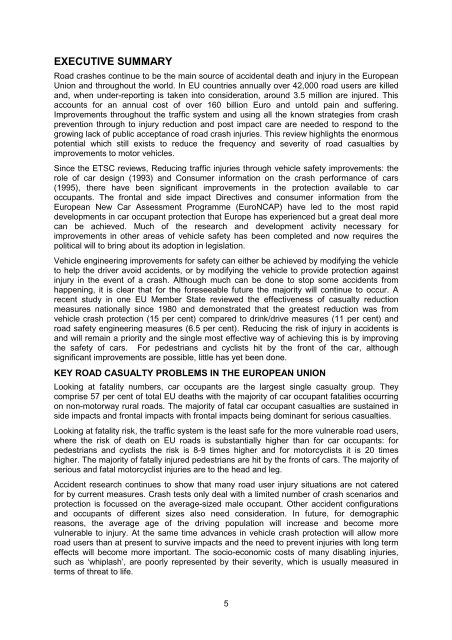PRIORITIES FOR EU MOTOR VEHICLE SAFETY DESIGN
priorities for eu motor vehicle safety design - ETSC
priorities for eu motor vehicle safety design - ETSC
You also want an ePaper? Increase the reach of your titles
YUMPU automatically turns print PDFs into web optimized ePapers that Google loves.
EXECUTIVE SUMMARY<br />
Road crashes continue to be the main source of accidental death and injury in the European<br />
Union and throughout the world. In <strong>EU</strong> countries annually over 42,000 road users are killed<br />
and, when under-reporting is taken into consideration, around 3.5 million are injured. This<br />
accounts for an annual cost of over 160 billion Euro and untold pain and suffering.<br />
Improvements throughout the traffic system and using all the known strategies from crash<br />
prevention through to injury reduction and post impact care are needed to respond to the<br />
growing lack of public acceptance of road crash injuries. This review highlights the enormous<br />
potential which still exists to reduce the frequency and severity of road casualties by<br />
improvements to motor vehicles.<br />
Since the ETSC reviews, Reducing traffic injuries through vehicle safety improvements: the<br />
role of car design (1993) and Consumer information on the crash performance of cars<br />
(1995), there have been significant improvements in the protection available to car<br />
occupants. The frontal and side impact Directives and consumer information from the<br />
European New Car Assessment Programme (EuroNCAP) have led to the most rapid<br />
developments in car occupant protection that Europe has experienced but a great deal more<br />
can be achieved. Much of the research and development activity necessary for<br />
improvements in other areas of vehicle safety has been completed and now requires the<br />
political will to bring about its adoption in legislation.<br />
Vehicle engineering improvements for safety can either be achieved by modifying the vehicle<br />
to help the driver avoid accidents, or by modifying the vehicle to provide protection against<br />
injury in the event of a crash. Although much can be done to stop some accidents from<br />
happening, it is clear that for the foreseeable future the majority will continue to occur. A<br />
recent study in one <strong>EU</strong> Member State reviewed the effectiveness of casualty reduction<br />
measures nationally since 1980 and demonstrated that the greatest reduction was from<br />
vehicle crash protection (15 per cent) compared to drink/drive measures (11 per cent) and<br />
road safety engineering measures (6.5 per cent). Reducing the risk of injury in accidents is<br />
and will remain a priority and the single most effective way of achieving this is by improving<br />
the safety of cars. For pedestrians and cyclists hit by the front of the car, although<br />
significant improvements are possible, little has yet been done.<br />
KEY ROAD CASUALTY PROBLEMS IN THE <strong>EU</strong>ROPEAN UNION<br />
Looking at fatality numbers, car occupants are the largest single casualty group. They<br />
comprise 57 per cent of total <strong>EU</strong> deaths with the majority of car occupant fatalities occurring<br />
on non-motorway rural roads. The majority of fatal car occupant casualties are sustained in<br />
side impacts and frontal impacts with frontal impacts being dominant for serious casualties.<br />
Looking at fatality risk, the traffic system is the least safe for the more vulnerable road users,<br />
where the risk of death on <strong>EU</strong> roads is substantially higher than for car occupants: for<br />
pedestrians and cyclists the risk is 8-9 times higher and for motorcyclists it is 20 times<br />
higher. The majority of fatally injured pedestrians are hit by the fronts of cars. The majority of<br />
serious and fatal motorcyclist injuries are to the head and leg.<br />
Accident research continues to show that many road user injury situations are not catered<br />
for by current measures. Crash tests only deal with a limited number of crash scenarios and<br />
protection is focussed on the average-sized male occupant. Other accident configurations<br />
and occupants of different sizes also need consideration. In future, for demographic<br />
reasons, the average age of the driving population will increase and become more<br />
vulnerable to injury. At the same time advances in vehicle crash protection will allow more<br />
road users than at present to survive impacts and the need to prevent injuries with long term<br />
effects will become more important. The socio-economic costs of many disabling injuries,<br />
such as ‘whiplash’, are poorly represented by their severity, which is usually measured in<br />
terms of threat to life.<br />
5



